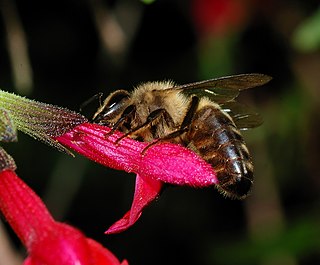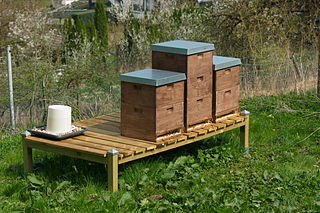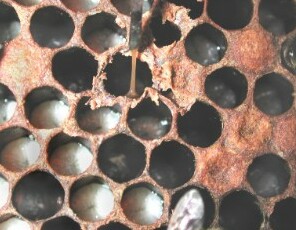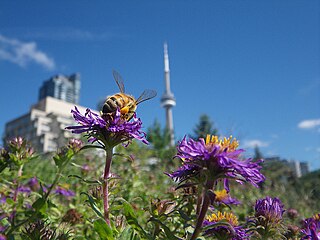
Beekeeping in New Zealand is reported to have commenced in 1839 with the importing of two skep hives by Mary Bumby, a missionary. [1] It has since become an established industry as well a hobby activity.

Beekeeping in New Zealand is reported to have commenced in 1839 with the importing of two skep hives by Mary Bumby, a missionary. [1] It has since become an established industry as well a hobby activity.
European honeybees were brought to New Zealand in 1839. [2] The Maori called them “the white man’s fly.” [3] Commercial beekeeping began in 1878 soon after the introduction of the Langstroth hive.
Isaac Hopkins (1837-1925) has been called the “father of beekeeping” in New Zealand. [4] He arrived in 1858 and went on to become a successful beekeeper, government apiarist and inspector of apiaries. He is the author of The illustrated New Zealand bee manual (1881) and The illustrated Australasian bee manual (1886). In his will he bequeathed £3000 to the Cawthron Institute in Nelson, New Zealand, for bee research. [5]
There are 28 species of native bees in New Zealand. They pollinate plants but do not produce enough honey for commercial harvesting.
New Zealand had 6,735 registered beekeepers in June 2016, who owned more than 600,000 hives in over 42,000 apiaries. [6] In 2015/16 total honey production was 19.8 thousand tonnes. The production of manuka honey, valued for its antibacterial properties, is increasingly important. Pollen, beeswax, and propolis are also produced and exported. Beekeepers provide pollination services to horticulturists, which used to generate more income than the products of bee culture. However, rising honey prices have pushed pollination fees to keep up. Approximately 42 thousand live queen bees, and 38 tonnes of packaged bees (which include approximately one kilogram of worker bees to support the queen) are exported live each year. [7]
The National Beekeepers' Association of New Zealand established "National Bee Week". [8]
The Green Party are calling for a phase out of pesticides that are toxic to bees as is happening in the European Union. [9]
Honey containing the poisonous tutin can be produced by bees feeding on honeydew produced by sap-sucking vine hopper insects (genus Scolypopa ) feeding on tutu, a plant native to New Zealand. [10] The last recorded deaths from eating honey containing tutin were in the 1890s. [11]
In May 2011 there were fears the colony collapse disorder had begun in New Zealand. Losses of up to 30% had been reported with Canterbury and Poverty Bay being hardest hit. [12] This suspicion was not confirmed, but high losses with an aetiology matching CCD could be observed in parts of the North Island in 2015, [13] reigniting these fears.
There were 925,000 registered hives in New Zealand by 2019. [14]
Pests include Nosema apis , Malpighamoeba mellifica and acarine mites. American foulbrood is present in a small percentage of hives with Sac brood and Chalk brood occurring in isolated cases. [15]
American foulbrood has been present in New Zealand since 1877. [16]
European foulbrood is not present in New Zealand. [17] In the 1990s suspected cases of European foulbrood were found and a wider survey of hives was carried out but the samples proved to be negative. [18]
The Varroa destructor mite, a parasite that attacks honey bees, was discovered in the North Island of New Zealand in 2000 and the South Island in 2008. [19] The Varroa mite is classed as a "Notifiable Organism" under the Biosecurity Act. [20]
Former or current legislation relevant to beekeeping in New Zealand include: [21]
There is also legislation relating to the bee products themselves.

A beehive is an enclosed structure in which some honey bee species of the subgenus Apis live and raise their young. Though the word beehive is commonly used to describe the nest of any bee colony, scientific and professional literature distinguishes nest from hive. Nest is used to discuss colonies that house themselves in natural or artificial cavities or are hanging and exposed. Hive is used to describe an artificial/man-made structure to house a honey bee nest. Several species of Apis live in colonies, but for honey production the western honey bee and the eastern honey bee are the main species kept in hives.

A beekeeper is a person who keeps honey bees.

Beekeeping is the maintenance of bee colonies, commonly in man-made hives, by humans. Most such bees are honey bees in the genus Apis, but other honey-producing bees such as Melipona stingless bees are also kept. A beekeeper keeps bees in order to collect their honey and other products that the hive produce, to pollinate crops, or to produce bees for sale to other beekeepers. A location where bees are kept is called an apiary or "bee yard".
An apiary is a location where beehives of honey bees are kept. Apiaries come in many sizes and can be rural or urban depending on the honey production operation. Furthermore, an apiary may refer to a hobbyist's hives or those used for commercial or educational usage. It can also be a wall-less, roofed structure, similar to a gazebo which houses hives, or an enclosed structure with an opening that directs the flight path of the bees.

The Buckfast bee is a breed of honey bee, a cross of many subspecies and their strains, developed by Brother Adam, who was in charge of beekeeping from 1919 at Buckfast Abbey in Devon in the United Kingdom. Breeding of the Buckfast bee is now done by breeders throughout Europe belonging to the Federation of European Buckfast Beekeepers (G.D.E.B.). This organization maintains a pedigree for Buckfast bees, originating from the time of Brother Adam.

The European dark bee is a subspecies of the western honey bee, evolving in central Asia and migrating into northern Europe after the last ice age from 9,000BC onwards. Its original range stretched from the southern Urals in Russia through northern Europe and down to the Pyrenees. They are one of the two members of the 'M' lineage of Apis mellifera, the other being in western China. They are large for honey bees though they have unusually short tongues (5.7-6.4 mm) and traditionally were called the German Dark Bee or the Black German Bee, names still used today even though they are now considered an Endangered Breed in Germany. Their common name is derived from their brown-black color, with only a few lighter yellow spots on the abdomen. However today they are more likely to be called after the geographic / political region in which they live such as the British Black Bee, the Native Irish Honey Bee, the Cornish Black Bee and the Nordic Brown Bee, even though they are all the same subspecies, with the word “native” often inserted by local beekeepers, even in places where the bee is an introduced foreign species. It was domesticated in Europe and hives were brought to North America in the colonial era in 1622 where they were referred to as the English Fly by the Native Americans.

In modern American beekeeping, a Langstroth hive is any vertically modular beehive that has the key features of vertically hung frames, a bottom board with entrance for the bees, boxes containing frames for brood and honey and an inner cover and top cap to provide weather protection. In a Langstroth hive, the bees build honeycomb into frames, which can be moved with ease. The frames are designed to prevent bees from attaching honeycombs where they would either connect adjacent frames, or connect frames to the walls of the hive. The movable frames allow the beekeeper to manage the bees in a way which was formerly impossible.

Varroa destructor is an external parasitic mite that attacks and feeds on the honey bees Apis cerana and Apis mellifera. The disease caused by the mites is called varroosis.

The small hive beetle is a beekeeping pest. It is endemic to sub-Saharan Africa, but has spread to many other locations, including North America, Australia, and the Philippines.

American foulbrood, caused by the spore-forming bacterium Paenibacillus larvae, is a highly infectious honey bee brood disease. It is the most widespread and destructive of the honey bee brood diseases. It is globally distributed and burning of infected colonied is often considered as the only effective measure to prevent spreading of the disease.

Fluvalinate is a synthetic pyrethroid chemical compound contained as an active agent in the products Apistan, Klartan, and Minadox, that is an acaricide, commonly used to control Varroa mites in honey bee colonies, infestations that constitute a significant disease of such insects.

Commercial Beekeeping in the United States dates back to the 1860s.

Colony collapse disorder (CCD) is an abnormal phenomenon that occurs when the majority of worker bees in a honey bee colony disappear, leaving behind a queen, plenty of food, and a few nurse bees to care for the remaining immature bees. While such disappearances have occurred sporadically throughout the history of apiculture, and have been known by various names, the syndrome was renamed colony collapse disorder in early 2007 in conjunction with a drastic rise in reports of disappearances of western honey bee colonies in North America. Beekeepers in most European countries had observed a similar phenomenon since 1998, especially in Southern and Western Europe; the Northern Ireland Assembly received reports of a decline greater than 50%. The phenomenon became more global when it affected some Asian and African countries as well.
Varroa sensitive hygiene (VSH) is a behavioral trait of honey bees (Apis mellifera) in which bees detect and remove bee pupae that are infested by the parasitic mite Varroa destructor. V. destructor is considered to be the most dangerous pest problem for honey bees worldwide. VSH activity results in significant resistance to the mites.
Beekeeping has been practised in Ireland for close to 1,500 years. It has seen a surge in popularity in modern times, with the membership of beekeeping associations exceeding 4,000. The growth in the practise has occurred despite increased pressures on bees and beekeepers due to parasites, diseases and habitat loss.
Beekeeping in the United Kingdom is the maintenance of bee colonies by humans within the United Kingdom. It is a significant commercial activity that provides those involved with honey, beeswax, royal jelly, queen bees, propolis, flower pollen and bee pollen. Honeybees also provide pollination services to orchards and a variety of seed crops.

The Apiary Laboratory, more often referred to as the Apiary, is a research laboratory at the University of Massachusetts Amherst. Originally built for the study of honey bees and apiculture, today it is primarily used to study native pollinator species and the chemicals and pathogens impacting their populations. This academic building is unique in that it is credited as being the first in the United States to be erected exclusively for the teaching of beekeeping.

Urban beekeeping is the practice of keeping bee colonies in urban areas. It is also referred to as hobby beekeeping or backyard beekeeping. Bees from city apiaries are said to be "healthier and more productive than their country cousins". Bees also provide environmental and economic benefits to cities.

Beekeeping in Australia is a commercial industry with around 25,000 registered beekeepers owning over 670,000 hives by 2019. Most are to be found in the eastern states of Queensland, New South Wales, Victoria and Tasmania and in the south-west corner of Western Australia.